EHR Implementation: A Nurse Manager's Leadership in Irish Elderly Care
VerifiedAdded on 2023/04/21
|7
|2141
|301
Essay
AI Summary
This essay explores the implementation of Electronic Health Record (EHR) systems in elderly care services in Ireland, focusing on the role of a nurse manager in ensuring its success. It discusses the application of change management theories, such as William Bridges' transition model and Kotter's 8-step change management model, to address the challenges and resistance associated with adopting EHRs. The essay highlights the importance of leadership skills, including communication, interpersonal abilities, and motivation, in guiding nurses through the transition. It also addresses potential challenges like cost concerns and inadequate training, proposing solutions such as cost-benefit analysis and comprehensive staff training. The ultimate goal is to improve patient safety and quality of care for the elderly population in Ireland by leveraging the benefits of EHR systems.
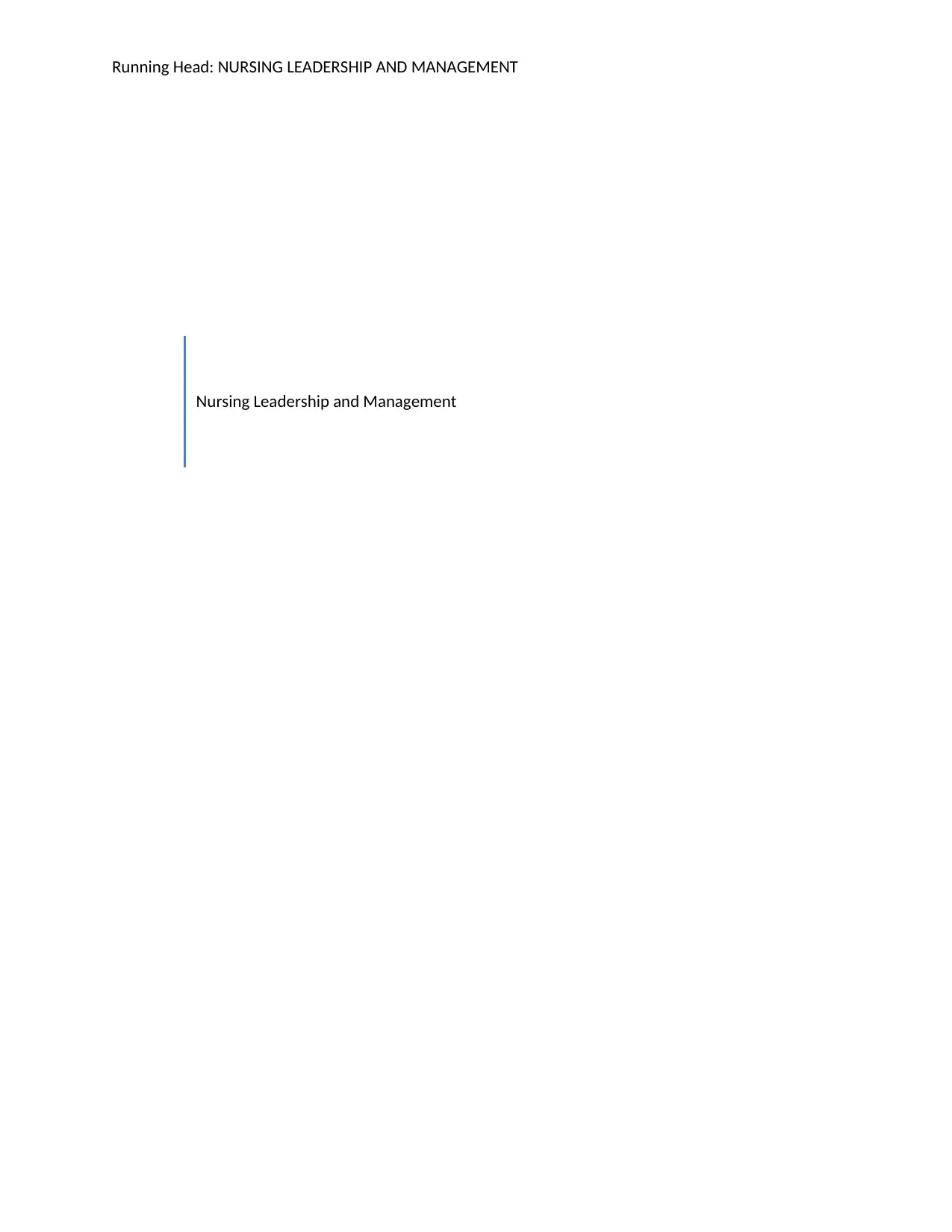
Running Head: NURSING LEADERSHIP AND MANAGEMENT
Nursing Leadership and Management
Nursing Leadership and Management
Paraphrase This Document
Need a fresh take? Get an instant paraphrase of this document with our AI Paraphraser
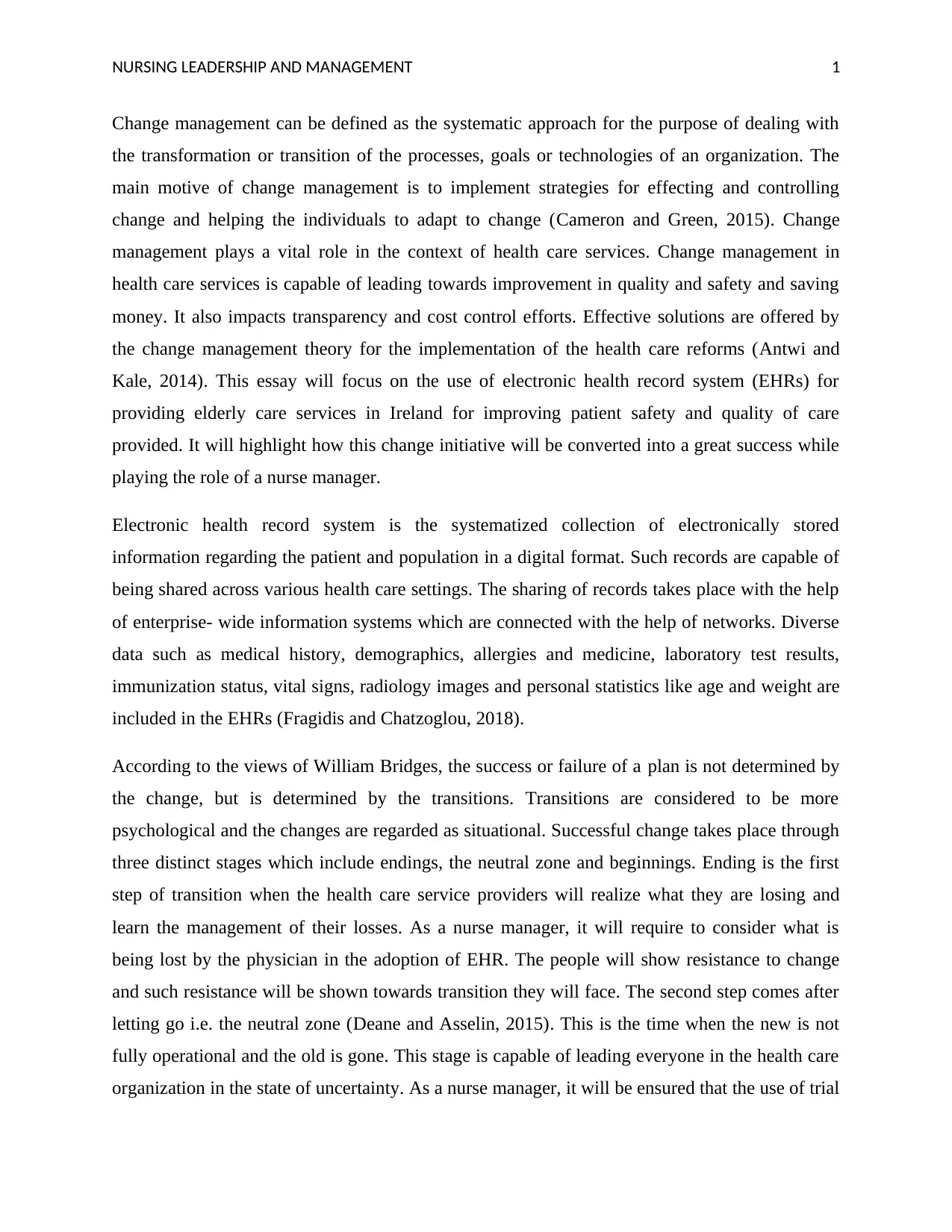
NURSING LEADERSHIP AND MANAGEMENT 1
Change management can be defined as the systematic approach for the purpose of dealing with
the transformation or transition of the processes, goals or technologies of an organization. The
main motive of change management is to implement strategies for effecting and controlling
change and helping the individuals to adapt to change (Cameron and Green, 2015). Change
management plays a vital role in the context of health care services. Change management in
health care services is capable of leading towards improvement in quality and safety and saving
money. It also impacts transparency and cost control efforts. Effective solutions are offered by
the change management theory for the implementation of the health care reforms (Antwi and
Kale, 2014). This essay will focus on the use of electronic health record system (EHRs) for
providing elderly care services in Ireland for improving patient safety and quality of care
provided. It will highlight how this change initiative will be converted into a great success while
playing the role of a nurse manager.
Electronic health record system is the systematized collection of electronically stored
information regarding the patient and population in a digital format. Such records are capable of
being shared across various health care settings. The sharing of records takes place with the help
of enterprise- wide information systems which are connected with the help of networks. Diverse
data such as medical history, demographics, allergies and medicine, laboratory test results,
immunization status, vital signs, radiology images and personal statistics like age and weight are
included in the EHRs (Fragidis and Chatzoglou, 2018).
According to the views of William Bridges, the success or failure of a plan is not determined by
the change, but is determined by the transitions. Transitions are considered to be more
psychological and the changes are regarded as situational. Successful change takes place through
three distinct stages which include endings, the neutral zone and beginnings. Ending is the first
step of transition when the health care service providers will realize what they are losing and
learn the management of their losses. As a nurse manager, it will require to consider what is
being lost by the physician in the adoption of EHR. The people will show resistance to change
and such resistance will be shown towards transition they will face. The second step comes after
letting go i.e. the neutral zone (Deane and Asselin, 2015). This is the time when the new is not
fully operational and the old is gone. This stage is capable of leading everyone in the health care
organization in the state of uncertainty. As a nurse manager, it will be ensured that the use of trial
Change management can be defined as the systematic approach for the purpose of dealing with
the transformation or transition of the processes, goals or technologies of an organization. The
main motive of change management is to implement strategies for effecting and controlling
change and helping the individuals to adapt to change (Cameron and Green, 2015). Change
management plays a vital role in the context of health care services. Change management in
health care services is capable of leading towards improvement in quality and safety and saving
money. It also impacts transparency and cost control efforts. Effective solutions are offered by
the change management theory for the implementation of the health care reforms (Antwi and
Kale, 2014). This essay will focus on the use of electronic health record system (EHRs) for
providing elderly care services in Ireland for improving patient safety and quality of care
provided. It will highlight how this change initiative will be converted into a great success while
playing the role of a nurse manager.
Electronic health record system is the systematized collection of electronically stored
information regarding the patient and population in a digital format. Such records are capable of
being shared across various health care settings. The sharing of records takes place with the help
of enterprise- wide information systems which are connected with the help of networks. Diverse
data such as medical history, demographics, allergies and medicine, laboratory test results,
immunization status, vital signs, radiology images and personal statistics like age and weight are
included in the EHRs (Fragidis and Chatzoglou, 2018).
According to the views of William Bridges, the success or failure of a plan is not determined by
the change, but is determined by the transitions. Transitions are considered to be more
psychological and the changes are regarded as situational. Successful change takes place through
three distinct stages which include endings, the neutral zone and beginnings. Ending is the first
step of transition when the health care service providers will realize what they are losing and
learn the management of their losses. As a nurse manager, it will require to consider what is
being lost by the physician in the adoption of EHR. The people will show resistance to change
and such resistance will be shown towards transition they will face. The second step comes after
letting go i.e. the neutral zone (Deane and Asselin, 2015). This is the time when the new is not
fully operational and the old is gone. This stage is capable of leading everyone in the health care
organization in the state of uncertainty. As a nurse manager, it will be ensured that the use of trial
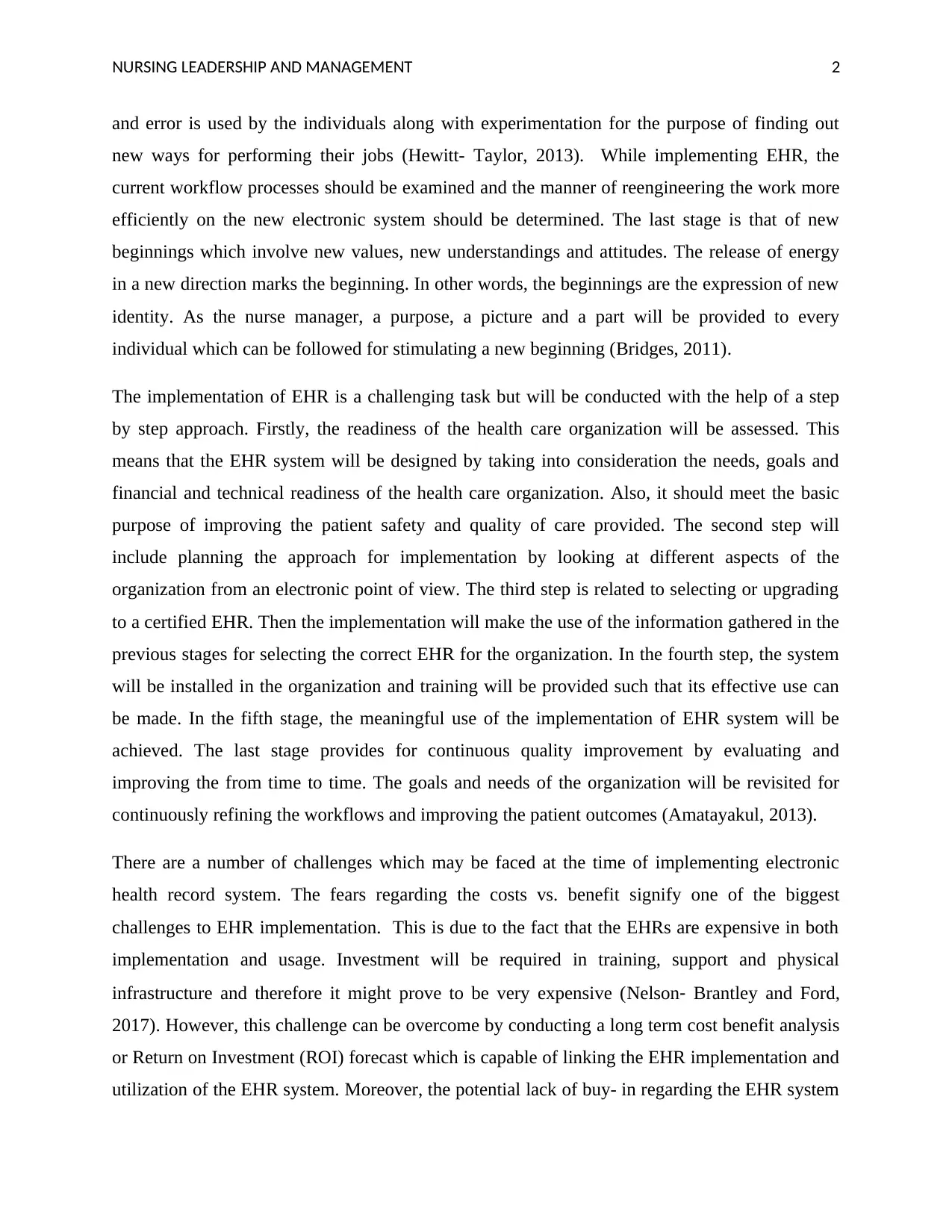
NURSING LEADERSHIP AND MANAGEMENT 2
and error is used by the individuals along with experimentation for the purpose of finding out
new ways for performing their jobs (Hewitt- Taylor, 2013). While implementing EHR, the
current workflow processes should be examined and the manner of reengineering the work more
efficiently on the new electronic system should be determined. The last stage is that of new
beginnings which involve new values, new understandings and attitudes. The release of energy
in a new direction marks the beginning. In other words, the beginnings are the expression of new
identity. As the nurse manager, a purpose, a picture and a part will be provided to every
individual which can be followed for stimulating a new beginning (Bridges, 2011).
The implementation of EHR is a challenging task but will be conducted with the help of a step
by step approach. Firstly, the readiness of the health care organization will be assessed. This
means that the EHR system will be designed by taking into consideration the needs, goals and
financial and technical readiness of the health care organization. Also, it should meet the basic
purpose of improving the patient safety and quality of care provided. The second step will
include planning the approach for implementation by looking at different aspects of the
organization from an electronic point of view. The third step is related to selecting or upgrading
to a certified EHR. Then the implementation will make the use of the information gathered in the
previous stages for selecting the correct EHR for the organization. In the fourth step, the system
will be installed in the organization and training will be provided such that its effective use can
be made. In the fifth stage, the meaningful use of the implementation of EHR system will be
achieved. The last stage provides for continuous quality improvement by evaluating and
improving the from time to time. The goals and needs of the organization will be revisited for
continuously refining the workflows and improving the patient outcomes (Amatayakul, 2013).
There are a number of challenges which may be faced at the time of implementing electronic
health record system. The fears regarding the costs vs. benefit signify one of the biggest
challenges to EHR implementation. This is due to the fact that the EHRs are expensive in both
implementation and usage. Investment will be required in training, support and physical
infrastructure and therefore it might prove to be very expensive (Nelson‐ Brantley and Ford,
2017). However, this challenge can be overcome by conducting a long term cost benefit analysis
or Return on Investment (ROI) forecast which is capable of linking the EHR implementation and
utilization of the EHR system. Moreover, the potential lack of buy- in regarding the EHR system
and error is used by the individuals along with experimentation for the purpose of finding out
new ways for performing their jobs (Hewitt- Taylor, 2013). While implementing EHR, the
current workflow processes should be examined and the manner of reengineering the work more
efficiently on the new electronic system should be determined. The last stage is that of new
beginnings which involve new values, new understandings and attitudes. The release of energy
in a new direction marks the beginning. In other words, the beginnings are the expression of new
identity. As the nurse manager, a purpose, a picture and a part will be provided to every
individual which can be followed for stimulating a new beginning (Bridges, 2011).
The implementation of EHR is a challenging task but will be conducted with the help of a step
by step approach. Firstly, the readiness of the health care organization will be assessed. This
means that the EHR system will be designed by taking into consideration the needs, goals and
financial and technical readiness of the health care organization. Also, it should meet the basic
purpose of improving the patient safety and quality of care provided. The second step will
include planning the approach for implementation by looking at different aspects of the
organization from an electronic point of view. The third step is related to selecting or upgrading
to a certified EHR. Then the implementation will make the use of the information gathered in the
previous stages for selecting the correct EHR for the organization. In the fourth step, the system
will be installed in the organization and training will be provided such that its effective use can
be made. In the fifth stage, the meaningful use of the implementation of EHR system will be
achieved. The last stage provides for continuous quality improvement by evaluating and
improving the from time to time. The goals and needs of the organization will be revisited for
continuously refining the workflows and improving the patient outcomes (Amatayakul, 2013).
There are a number of challenges which may be faced at the time of implementing electronic
health record system. The fears regarding the costs vs. benefit signify one of the biggest
challenges to EHR implementation. This is due to the fact that the EHRs are expensive in both
implementation and usage. Investment will be required in training, support and physical
infrastructure and therefore it might prove to be very expensive (Nelson‐ Brantley and Ford,
2017). However, this challenge can be overcome by conducting a long term cost benefit analysis
or Return on Investment (ROI) forecast which is capable of linking the EHR implementation and
utilization of the EHR system. Moreover, the potential lack of buy- in regarding the EHR system
⊘ This is a preview!⊘
Do you want full access?
Subscribe today to unlock all pages.

Trusted by 1+ million students worldwide
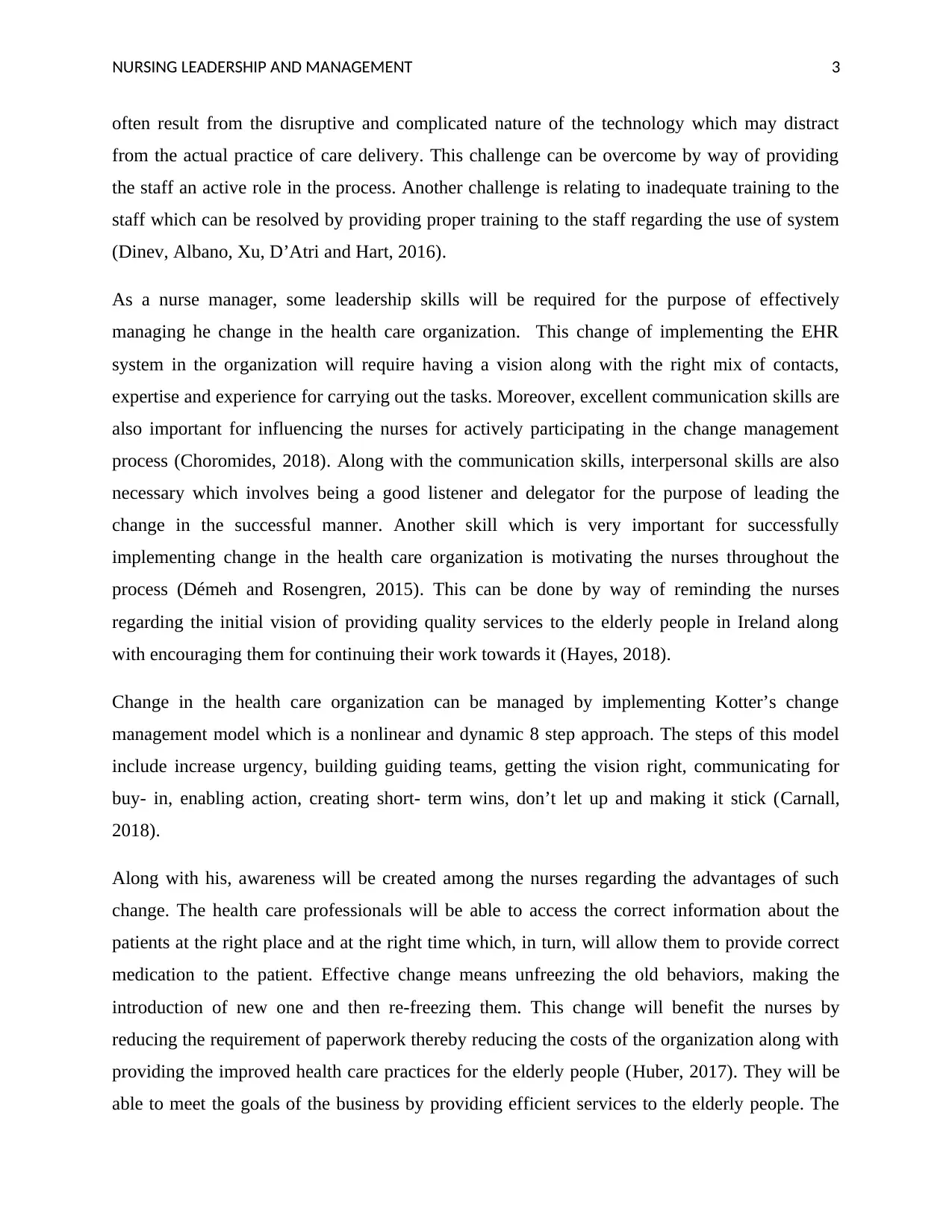
NURSING LEADERSHIP AND MANAGEMENT 3
often result from the disruptive and complicated nature of the technology which may distract
from the actual practice of care delivery. This challenge can be overcome by way of providing
the staff an active role in the process. Another challenge is relating to inadequate training to the
staff which can be resolved by providing proper training to the staff regarding the use of system
(Dinev, Albano, Xu, D’Atri and Hart, 2016).
As a nurse manager, some leadership skills will be required for the purpose of effectively
managing he change in the health care organization. This change of implementing the EHR
system in the organization will require having a vision along with the right mix of contacts,
expertise and experience for carrying out the tasks. Moreover, excellent communication skills are
also important for influencing the nurses for actively participating in the change management
process (Choromides, 2018). Along with the communication skills, interpersonal skills are also
necessary which involves being a good listener and delegator for the purpose of leading the
change in the successful manner. Another skill which is very important for successfully
implementing change in the health care organization is motivating the nurses throughout the
process (Démeh and Rosengren, 2015). This can be done by way of reminding the nurses
regarding the initial vision of providing quality services to the elderly people in Ireland along
with encouraging them for continuing their work towards it (Hayes, 2018).
Change in the health care organization can be managed by implementing Kotter’s change
management model which is a nonlinear and dynamic 8 step approach. The steps of this model
include increase urgency, building guiding teams, getting the vision right, communicating for
buy- in, enabling action, creating short- term wins, don’t let up and making it stick (Carnall,
2018).
Along with his, awareness will be created among the nurses regarding the advantages of such
change. The health care professionals will be able to access the correct information about the
patients at the right place and at the right time which, in turn, will allow them to provide correct
medication to the patient. Effective change means unfreezing the old behaviors, making the
introduction of new one and then re-freezing them. This change will benefit the nurses by
reducing the requirement of paperwork thereby reducing the costs of the organization along with
providing the improved health care practices for the elderly people (Huber, 2017). They will be
able to meet the goals of the business by providing efficient services to the elderly people. The
often result from the disruptive and complicated nature of the technology which may distract
from the actual practice of care delivery. This challenge can be overcome by way of providing
the staff an active role in the process. Another challenge is relating to inadequate training to the
staff which can be resolved by providing proper training to the staff regarding the use of system
(Dinev, Albano, Xu, D’Atri and Hart, 2016).
As a nurse manager, some leadership skills will be required for the purpose of effectively
managing he change in the health care organization. This change of implementing the EHR
system in the organization will require having a vision along with the right mix of contacts,
expertise and experience for carrying out the tasks. Moreover, excellent communication skills are
also important for influencing the nurses for actively participating in the change management
process (Choromides, 2018). Along with the communication skills, interpersonal skills are also
necessary which involves being a good listener and delegator for the purpose of leading the
change in the successful manner. Another skill which is very important for successfully
implementing change in the health care organization is motivating the nurses throughout the
process (Démeh and Rosengren, 2015). This can be done by way of reminding the nurses
regarding the initial vision of providing quality services to the elderly people in Ireland along
with encouraging them for continuing their work towards it (Hayes, 2018).
Change in the health care organization can be managed by implementing Kotter’s change
management model which is a nonlinear and dynamic 8 step approach. The steps of this model
include increase urgency, building guiding teams, getting the vision right, communicating for
buy- in, enabling action, creating short- term wins, don’t let up and making it stick (Carnall,
2018).
Along with his, awareness will be created among the nurses regarding the advantages of such
change. The health care professionals will be able to access the correct information about the
patients at the right place and at the right time which, in turn, will allow them to provide correct
medication to the patient. Effective change means unfreezing the old behaviors, making the
introduction of new one and then re-freezing them. This change will benefit the nurses by
reducing the requirement of paperwork thereby reducing the costs of the organization along with
providing the improved health care practices for the elderly people (Huber, 2017). They will be
able to meet the goals of the business by providing efficient services to the elderly people. The
Paraphrase This Document
Need a fresh take? Get an instant paraphrase of this document with our AI Paraphraser
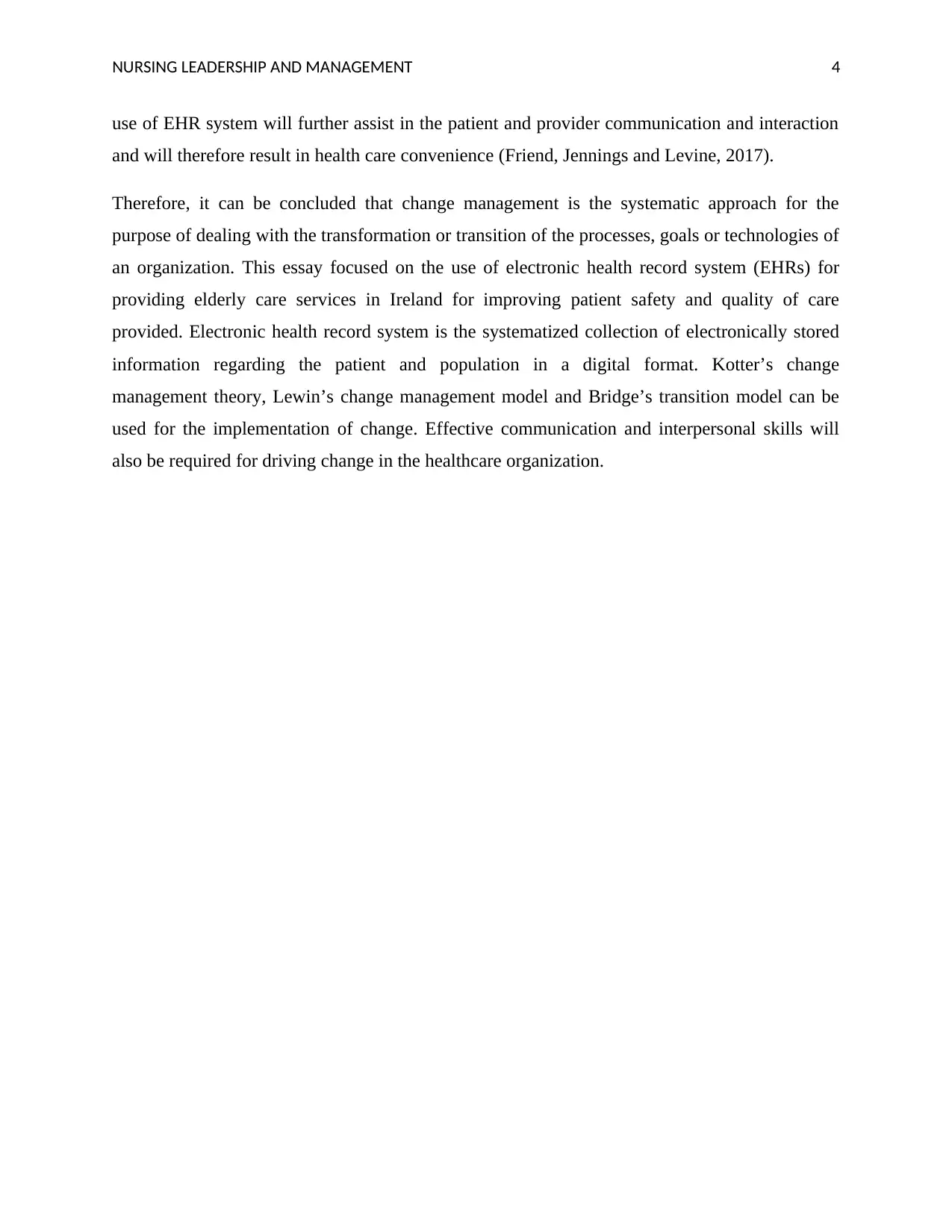
NURSING LEADERSHIP AND MANAGEMENT 4
use of EHR system will further assist in the patient and provider communication and interaction
and will therefore result in health care convenience (Friend, Jennings and Levine, 2017).
Therefore, it can be concluded that change management is the systematic approach for the
purpose of dealing with the transformation or transition of the processes, goals or technologies of
an organization. This essay focused on the use of electronic health record system (EHRs) for
providing elderly care services in Ireland for improving patient safety and quality of care
provided. Electronic health record system is the systematized collection of electronically stored
information regarding the patient and population in a digital format. Kotter’s change
management theory, Lewin’s change management model and Bridge’s transition model can be
used for the implementation of change. Effective communication and interpersonal skills will
also be required for driving change in the healthcare organization.
use of EHR system will further assist in the patient and provider communication and interaction
and will therefore result in health care convenience (Friend, Jennings and Levine, 2017).
Therefore, it can be concluded that change management is the systematic approach for the
purpose of dealing with the transformation or transition of the processes, goals or technologies of
an organization. This essay focused on the use of electronic health record system (EHRs) for
providing elderly care services in Ireland for improving patient safety and quality of care
provided. Electronic health record system is the systematized collection of electronically stored
information regarding the patient and population in a digital format. Kotter’s change
management theory, Lewin’s change management model and Bridge’s transition model can be
used for the implementation of change. Effective communication and interpersonal skills will
also be required for driving change in the healthcare organization.
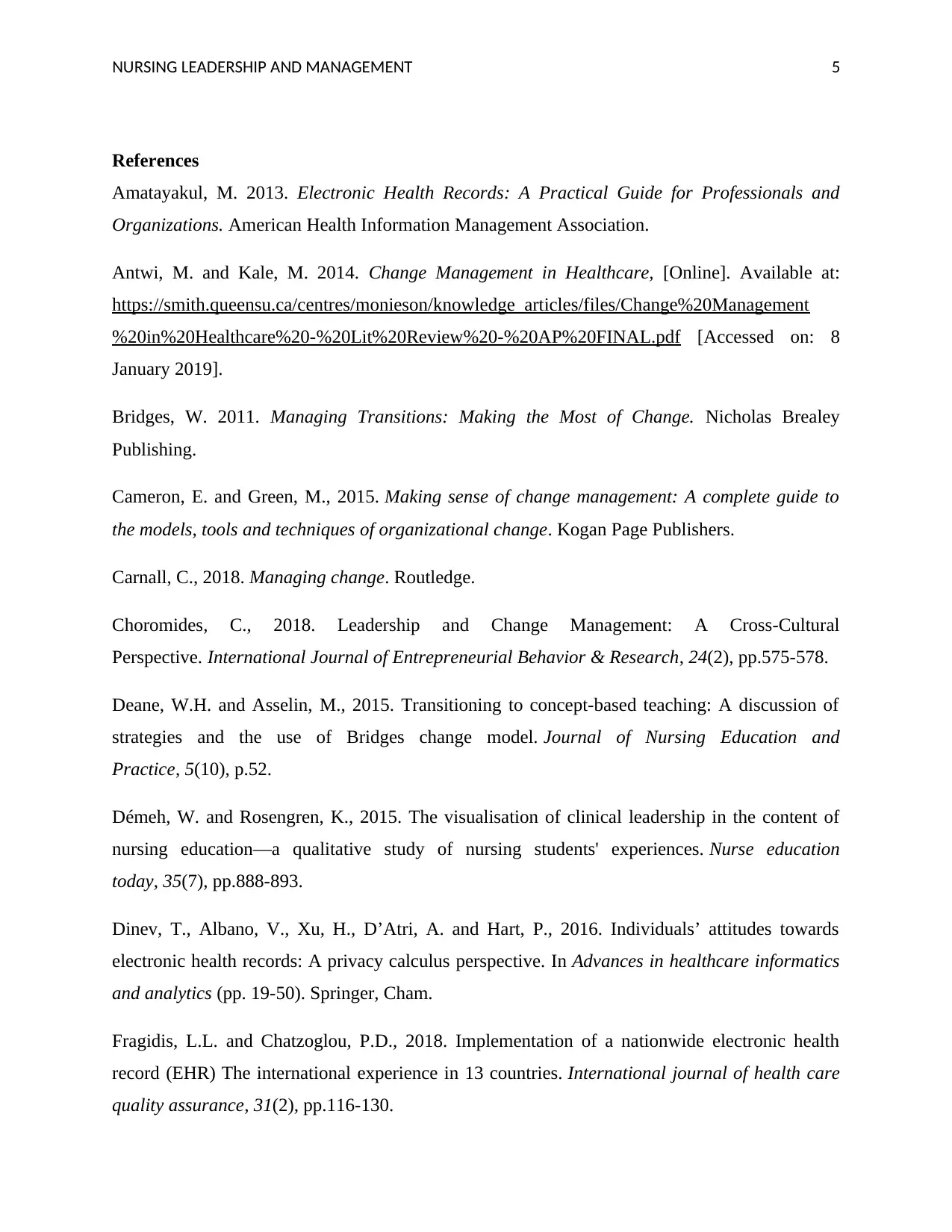
NURSING LEADERSHIP AND MANAGEMENT 5
References
Amatayakul, M. 2013. Electronic Health Records: A Practical Guide for Professionals and
Organizations. American Health Information Management Association.
Antwi, M. and Kale, M. 2014. Change Management in Healthcare, [Online]. Available at:
https://smith.queensu.ca/centres/monieson/knowledge_articles/files/Change%20Management
%20in%20Healthcare%20-%20Lit%20Review%20-%20AP%20FINAL.pdf [Accessed on: 8
January 2019].
Bridges, W. 2011. Managing Transitions: Making the Most of Change. Nicholas Brealey
Publishing.
Cameron, E. and Green, M., 2015. Making sense of change management: A complete guide to
the models, tools and techniques of organizational change. Kogan Page Publishers.
Carnall, C., 2018. Managing change. Routledge.
Choromides, C., 2018. Leadership and Change Management: A Cross-Cultural
Perspective. International Journal of Entrepreneurial Behavior & Research, 24(2), pp.575-578.
Deane, W.H. and Asselin, M., 2015. Transitioning to concept-based teaching: A discussion of
strategies and the use of Bridges change model. Journal of Nursing Education and
Practice, 5(10), p.52.
Démeh, W. and Rosengren, K., 2015. The visualisation of clinical leadership in the content of
nursing education—a qualitative study of nursing students' experiences. Nurse education
today, 35(7), pp.888-893.
Dinev, T., Albano, V., Xu, H., D’Atri, A. and Hart, P., 2016. Individuals’ attitudes towards
electronic health records: A privacy calculus perspective. In Advances in healthcare informatics
and analytics (pp. 19-50). Springer, Cham.
Fragidis, L.L. and Chatzoglou, P.D., 2018. Implementation of a nationwide electronic health
record (EHR) The international experience in 13 countries. International journal of health care
quality assurance, 31(2), pp.116-130.
References
Amatayakul, M. 2013. Electronic Health Records: A Practical Guide for Professionals and
Organizations. American Health Information Management Association.
Antwi, M. and Kale, M. 2014. Change Management in Healthcare, [Online]. Available at:
https://smith.queensu.ca/centres/monieson/knowledge_articles/files/Change%20Management
%20in%20Healthcare%20-%20Lit%20Review%20-%20AP%20FINAL.pdf [Accessed on: 8
January 2019].
Bridges, W. 2011. Managing Transitions: Making the Most of Change. Nicholas Brealey
Publishing.
Cameron, E. and Green, M., 2015. Making sense of change management: A complete guide to
the models, tools and techniques of organizational change. Kogan Page Publishers.
Carnall, C., 2018. Managing change. Routledge.
Choromides, C., 2018. Leadership and Change Management: A Cross-Cultural
Perspective. International Journal of Entrepreneurial Behavior & Research, 24(2), pp.575-578.
Deane, W.H. and Asselin, M., 2015. Transitioning to concept-based teaching: A discussion of
strategies and the use of Bridges change model. Journal of Nursing Education and
Practice, 5(10), p.52.
Démeh, W. and Rosengren, K., 2015. The visualisation of clinical leadership in the content of
nursing education—a qualitative study of nursing students' experiences. Nurse education
today, 35(7), pp.888-893.
Dinev, T., Albano, V., Xu, H., D’Atri, A. and Hart, P., 2016. Individuals’ attitudes towards
electronic health records: A privacy calculus perspective. In Advances in healthcare informatics
and analytics (pp. 19-50). Springer, Cham.
Fragidis, L.L. and Chatzoglou, P.D., 2018. Implementation of a nationwide electronic health
record (EHR) The international experience in 13 countries. International journal of health care
quality assurance, 31(2), pp.116-130.
⊘ This is a preview!⊘
Do you want full access?
Subscribe today to unlock all pages.

Trusted by 1+ million students worldwide

NURSING LEADERSHIP AND MANAGEMENT 6
Friend, T.H., Jennings, S.J. and Levine, W.C., 2017. Communication patterns in the
perioperative environment during epic electronic health record system implementation. Journal
of medical systems, 41(2), p.22.
Hayes, J., 2018. The theory and practice of change management.
Hewitt- Taylor, J. 2013. Understanding and Managing Change in Healthcare: A Step-by-Step
Guide. Macmillan International Higher Education.
Huber, D., 2017. Leadership and Nursing Care Management-E-Book. Elsevier Health Sciences.
Nelson‐ Brantley, H.V. and Ford, D.J., 2017. Leading change: a concept analysis. Journal of
advanced nursing, 73(4), pp.834-846.
Friend, T.H., Jennings, S.J. and Levine, W.C., 2017. Communication patterns in the
perioperative environment during epic electronic health record system implementation. Journal
of medical systems, 41(2), p.22.
Hayes, J., 2018. The theory and practice of change management.
Hewitt- Taylor, J. 2013. Understanding and Managing Change in Healthcare: A Step-by-Step
Guide. Macmillan International Higher Education.
Huber, D., 2017. Leadership and Nursing Care Management-E-Book. Elsevier Health Sciences.
Nelson‐ Brantley, H.V. and Ford, D.J., 2017. Leading change: a concept analysis. Journal of
advanced nursing, 73(4), pp.834-846.
1 out of 7
Related Documents
Your All-in-One AI-Powered Toolkit for Academic Success.
+13062052269
info@desklib.com
Available 24*7 on WhatsApp / Email
![[object Object]](/_next/static/media/star-bottom.7253800d.svg)
Unlock your academic potential
Copyright © 2020–2025 A2Z Services. All Rights Reserved. Developed and managed by ZUCOL.





